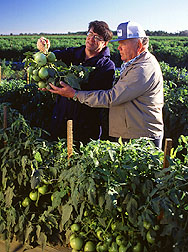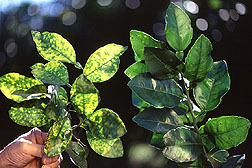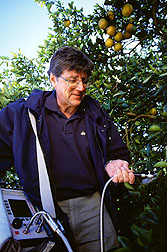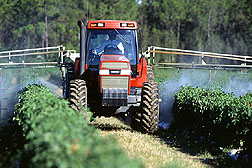Exploiting Plants' Protective Proteins
Like our own bodies that valiantly fight off infections, plants also have built-in protective mechanisms.
In plants, this system can be triggered by pathogenesis-related (PR) proteins. These proteins are induced and start working when an outside enemy--an insect or a disease-causing pathogen, for example--invades the plant.
As it feeds on a plant, an insect can release substances in saliva that can turn on defensive proteins. Or the action of plant cells being disrupted by insect feeding can trigger the proteins. And proteins and carbohydrates secreted by pathogenic fungi can also initiate protective measures in plants.
"For several years, we've been studying plant responses to disease and insect pests," says Agricultural Research Service chemist Richard T. Mayer. "A plant may have resistance mechanisms, but the damage from pathogens or pests often overwhelms the plant before it can marshal its defenses."
Mayer heads research at the U.S. Horticultural Research Laboratory, the ARS research facility that will soon move from Orlando to Fort Pierce, Florida. At Orlando, Mayer and colleagues Hamed Doostdar, Moshe Inbar, Gregory T. McCollum, and Roy E. McDonald have identified more than 20 PR proteins in citrus.
According to Mayer, scientists have known that plants contain protective proteins but not that they exist in citrus. He and colleagues found two classes of enzymes--chitinases and glucanases--in citrus.
"We found these enzymes in citrus roots, leaves, blossoms, and fruit," Mayer reports. "Once we knew that the compounds were present in citrus, our next goal was to find a way to elicit them, or make them become more active."
To help learn more about plant defenses, the Florida Citrus Production Research Advisory Council supports the ARS research with funding from a self-imposed grower tax. If plants can better defend themselves, growers will spend less money on fungicides and insecticides and greatly benefit the environment.
Three New Defense Products
The plant defense research has already led to one industry partnership, a cooperative research and development agreement (CRADA) with Morse Enterprises Limited, Inc., in Miami, Florida. From this, three products--KeyPlex 250-DP, 350-DP, and 445-DP--are being marketed in the United States, and the company is expanding the market to Central America and the Caribbean Basin. These products are as effective as fungicides against two diseases that plague citrus: greasy spot, Mycosphaerella citri, and postbloom fruit drop, Colletotrichum acutatum.
Morse Enterprises markets fertilizer supplements for foliar or soil application. Because Florida's well-drained soil often contains lots of calcium and very little organic matter and gets ample rain, growers usually add nutrients to the soil or the foliage to boost productivity.
|
|
George C. Butler, Jr., vice president of Morse Enterprises, explains, "We brought three products to Dr. Mayer's lab for evaluation. Our original products were micronutrients that could be used to make plants healthier. ARS scientists added other naturally occurring compounds that increase plant resistance by causing them to produce more pathogenesis-related proteins."
These jointly developed products can be sprayed on plants or incorporated into the soil to protect citrus and tomato crops. Butler says that in field tests, KeyPlex 350-DP reduced the incidence of postbloom fruit drop of navel oranges by 80 percent.
KeyPlex is also effective against whiteflies. Their feeding on crops can introduce a geminivirus that significantly affects tomato plants.
"Treatment of tomato plants with KeyPlex 350-DP reduced the numbers of whitefly adults, pupae, and eggs. Whiteflies seem to prefer untreated plants," says Butler.
KeyPlex products are being used on citrus, bush beans, and tomatoes and tested on limes, bananas, bell peppers, and cotton. Future tests will include squash and other cucurbits. The label list is being extended to include most vegetable and fruit crops.
"We've tested KeyPlex 350-DP on bananas in Florida and Central America against yellow and black Sigatoka," says Butler. "We have had significant reduction of both diseases, which are significant problems for growers in Central America and the Caribbean Basin. Three major banana growers there are interested in testing KeyPlex 350-DP because treating Sigatoka diseases with expensive fungicides is not totally effective."
Made from naturally occurring compounds, KeyPlex products don't require registration by the Environmental Protection Agency. "KeyPlex products are no more toxic to humans, animals, plants, or insects than common fertilizer," Butler says. "They work by causing the plant to produce more of the compounds that resist pathogens and repel insects."
Boosting Plants' Protective Proteins
For 6 years, ARS chemist Hamed Doostdar has been working on identifying and purifying plant-protective proteins in citrus.
|
|
"Purifying the proteins enables us to characterize them--that is, to determine their composition and activity. We must know how these proteins work and where they're located within the plant's structure," he says. "If we expect to manipulate these proteins in plants, then we must first understand how and why they occur."
Along with McCollum, Doostdar has isolated genes that produce these protective proteins. The newly isolated genes are now in gene banks for public use.
"Once you have the gene, it can be inserted into a plant that doesn't have that gene, if it does something you want that plant to do," Doostdar says. "Even if a plant has a desirable gene, it might be useful to have a transgenic plant that expresses the protein in larger quantities or at a different place in the plant or at a different time.
"The next step for us has been to see if we can manipulate the levels of the compounds in existing plants without having to produce transgenic plants," says Doostdar. "It takes years to get transgenic plants approved and released, and in tree crops like citrus, you get no fruit for the first 4 or 5," he says. This means that it would not be economically feasible for growers to get rid of existing groves and replant with transgenic plants, even if plants were available. Growers could possibly replace diseased or nonproductive trees with transgenic ones, but most could not start over.
Because of this, Doostdar and colleagues have begun looking at ways to evoke protective compounds in existing plants.
"We started looking at chemicals that would start the protective mechanism without the plant being actually attacked by a pest," says ARS entomologist Inbar.
Inbar got his best results with BTH (benzothiadiazole), a nontoxic chemical developed by Novartis, formerly Ciba Geigy. The compound does not harm humans, livestock, wild or domestic animals, or plants. When sprayed on crops such as tomatoes, it starts an internal chemical chain reaction that reduces the number of leafminers.
A secondary pest of Florida's vegetable crops, leafminers are now treated with chemicals and biocontrol strategies.
Tomato fields treated with BTH had 30 percent less leafminers than untreated fields. A tomato crop takes about 2 to 3 months to grow, and treatment should begin 1 week before young seedlings are transplanted to the field. After transplanting, plants should be sprayed about every third week.
Because of this research, Novartis has amended its patents on BTH to include insect pests. The patents originally covered protection against pathogenic fungi and bacteria.
Postharvest Use of Elicitors
Harvested fruits and vegetables also have built-in protective mechanisms, according to ARS horticulturist Roy McDonald.
"When we found the enzyme chitinase in citrus fruit, we knew it must be a protective compound because its purpose is to break down chitin and there is none in citrus," he explains. "But insects' exoskeletons are made of chitin--as are the walls of microbial pathogens. So we presume chitinase is there to protect the fruit, since it becomes active when the fruit is attacked by a pathogen."
Plant physiologist McCollum has been working on glucanases. These enzymes break down glucans, which are anti-fungal compounds found in citrus. He has also purified a polygalacturonase inhibitor protein (PGIP) from grapefruit peel.
"This protein may play a role in fungal resistance," says McCollum. "Fungi release pectinases during the infection process. PGIP proteins inhibit pectinase production, thereby preventing the fungus from growing."
Lab director Mayer says that PGIP proteins may also prove valuable in increasing resistance to insect pests.
"Insects secrete pectinase when they feed. If we can get transgenic citrus plants to express PGIP, then we have an excellent chance of producing insect-resistant plants."
Dual Protection for Sweet Oranges
The West Indies sugarcane rootstalk borer weevil, Diaprepes abbreviatus, and the fungal pathogen Phytophthora parasitica are two interrelated problems for citrus growers.
Diaprepes larvae feed on citrus roots, causing plant decline and death. Injured roots are more susceptible to infection by the fungi that cause foot rot. Most of the best citrus varieties are sweet oranges whose roots are highly susceptible to foot rot, so they must be grafted on more resistant rootstocks. Mayer and colleagues are using the pathogenesis-related protein approach on these problems.
"We've identified substances that stop the larvae from feeding, and we've isolated a gene from citrus varieties resistant to foot rot that may confer Phytophthora resistance," Mayer reports.
"What we're hoping for is to put this gene into a sweet orange like Valencia to see if it can be grown on its own roots and still resist Phytophthora." -- ByDoris Stanley, Agricultural Research Service Information staff, 128 Smallwood Village Center, Waldorf, MD 20602, phone (301) 893-6727.
Richard T. Mayer and other scientists in this article can be reached at the USDA-ARS U.S. Horticultural Research Laboratory, 2120 Camden Road, Orlando, FL 32803; phone 407-897-7300, fax 407-897-7309.
"Exploiting Plants' Protective Proteins" was published in the May 1998 issue of Agricultural Research magazine. Click here to see this issue's table of contents.










